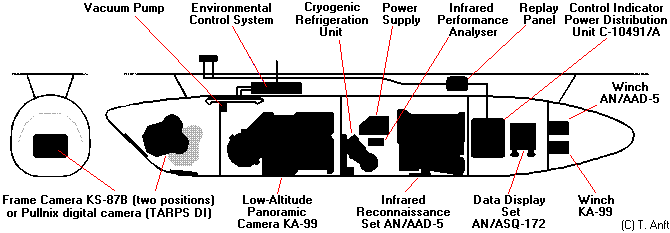Tactical Airborne Reconnaisance Pod System |
|
 |
|
| F-14 TARPS equipped ... or Peeping Tom.
The TARPS is today the only possibility for the Navy to get tactical information about an area or
target via a fast flying aircraft, the F-14. No other platform - except unmanned recconnaisance
drones - is able to perform this mission in todays Navy. Since the retirement of the RF-8, the
RF-4B and various A-3 Skywarrior variants, the F-14 is the sole aircraft for this role (and can
carry at the same time a complete range of air-to-air weapons!) until the introduction
of a F/A-18 recce aircraft with reconnaisance equipment instead of a gun! (How will this aircraft
be called? R/F/A-18?! The follow-on electronic version could be E/R/F/A-18 ...)
Early prototype TARPS pods had a little different shape plus fins and were installed under the
air inlet instead of a external fuel tank. |
| TARPS DI (TARPS Digital Imagery) In September 1995 plans were issued to test
a digital camera system for the TARPS pod on the F-14. Just seven month later, by June 1996 VF-32
had modified one of their Tomcats to carry the new pod, completed ground testing and test flights.
In the new TARPS DI pod the standard KS-87 camera is replaced by a Pullnix digital camera with
one vertical and one forward viewfinder. When a digital image is taken and stored in a solid-state
storage device, the RIO has several alternatives: He might send the image immediately to the
decision makers (who might immediately order a strike on the target) and leave the image in
storage for review/later transmission or he might store all images and wait for download after
return to the carrier. If the image is transmitted immediately, it is done via the UHF radio in
30 to 180 seconds per image at a 175 nautical miles distance. |
| Before the introduction of the digital TARPS data transmission, the transfer of
reconnaissance photos was somewhat difficult. E.g. in the 1991 Gulf War F-14 TARPS reconnaissance
missions did not end on the aircraft carrier, but the processed TARPS photography was dropped by
S-3 Vikings over allied ground commanders to give them up-to-date target informations. |




